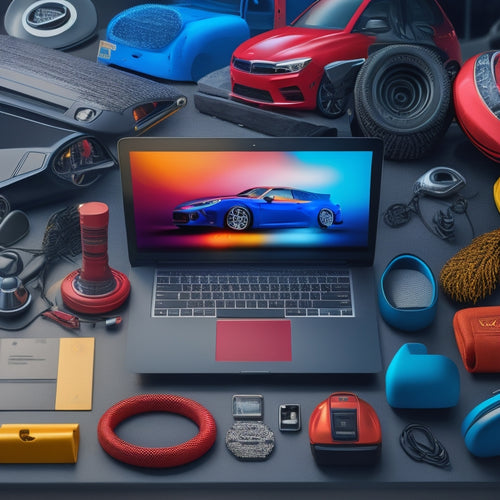
What Are the Essential Components of Solar Panels and Systems?
Share
When it comes to generating electricity from sunlight, you rely on several essential components working harmoniously together. Your solar panel system consists of photovoltaic cells, inverters, charge controllers, batteries, electrical connections, wiring, and mounting hardware. Each component plays a vital role in converting sunlight into usable electricity, from DC to AC conversion to energy regulation and storage. Understanding the functionality and compatibility of these components is fundamental to ensuring peak performance and safety. As you investigate the complexities of solar panel systems, you'll uncover how these components interact and how to enhance their performance to maximize your energy output.
Key Takeaways
- Solar panels, comprising photovoltaic cells, convert sunlight to electricity, with types including monocrystalline, polycrystalline, and thin-film.
- Inverters convert DC power from solar panels to AC power for home use, with options including string, micro, and power optimizer inverters.
- Charge controllers regulate energy flow from solar panels to battery banks, with types including MPPT and PWM controllers, ensuring optimal performance.
- Battery storage systems, including lead-acid, lithium-ion, and flow batteries, provide backup power and require proper maintenance for extended lifespan.
- Electrical connections, wiring, and components, such as MC4 connectors and DC cables, facilitate power flow and require adherence to safety standards for reliability.
Solar Panel Components Explained
You're likely familiar with solar panels, but have you ever wondered what makes them tick? The answer lies in the intricate components that work together to convert sunlight into electrical energy.
At the heart of every solar panel are photovoltaic (PV) cells, which come in various types, including monocrystalline, polycrystalline, and thin-film. Each type has its own strengths and weaknesses, affecting the overall photovoltaic efficiency of the panel. Monocrystalline cells, for instance, boast high efficiency rates but are more expensive, while polycrystalline cells offer a more affordable option with slightly lower efficiency.
The PV cells are arranged in a grid-like pattern on the panel's surface, protected by a layer of tempered glass or plastic. The cells are connected by metal wires, allowing the flow of electrical current.
The panel's efficiency is also influenced by the quality of the materials used, the manufacturing process, and the panel's overall design. Understanding these components and how they interact is essential for maximizing the energy output of your solar panel system.
Inverter and Mounting Hardware
You're now ready to investigate the essential components that connect and support your solar panel system.
The inverter plays a significant role in converting DC power into usable AC power, while mounting hardware guarantees your panels are securely fastened to your roof or ground.
Inverter Functionality Explained
In conjunction with the photovoltaic cells, the inverter plays an important role in converting the DC power generated by the solar panels into AC power, which is usable in homes and businesses. As you investigate inverter options, you'll come across different types, including string inverters, microinverters, and power optimizers. Each type has its benefits, and the right choice depends on your specific solar panel system.
When selecting an inverter, consider factors such as efficiency, sizing, and placement. Inverter efficiency measures how effectively the device converts DC power to AC power. Proper sizing guarantees the inverter can handle the maximum power output of your solar panels. Placement is vital, as it affects the inverter's performance and lifespan.
| Inverter Feature | Description |
|---|---|
| Efficiency | Measures the percentage of DC power converted to AC power |
| Sizing | Determines the maximum power output the inverter can handle |
| Placement | Affects inverter performance and lifespan, with options including indoor and outdoor installations |
| Lifespan | Typically ranges from 10 to 25 years, depending on the quality and type of inverter |
Mounting Hardware Options
As solar panels are installed, securing them to the roof or ground is essential to guarantee their performance and longevity, which is where mounting hardware comes into play.
You'll need to decide on the type of mounting system that best suits your solar panel installation. Fixed mounts provide a stable, cost-effective solution, while adjustable mounts offer flexibility regarding tilt and direction.
Ground mounts and roof mounts cater to different installation scenarios, with rack systems providing a secure and durable structure. Solar trackers, on the other hand, optimize energy output by following the sun's movement.
When selecting a mounting system, consider installation techniques, material choices, and cost considerations. Aesthetic options, such as sleek and modern designs, can also influence your decision.
Charge Controllers and Monitoring
By utilizing the power of solar energy, your system relies on efficient charging and monitoring to guarantee peak performance. To achieve this, you'll need a charge controller, which regulates the flow of energy from your solar panels to your battery bank.
There are two primary charge controller types: maximum power point tracking (MPPT) and pulse-width modulation (PWM) controllers. MPPT controllers are more efficient, as they enhance energy harvesting by continuously tracking the maximum power point of your solar panels. PWM controllers, on the other hand, are simpler and less expensive, but may not be as efficient.
In addition to a charge controller, a monitoring system is essential to track your system's performance and identify potential issues. Monitoring systems typically consist of a display unit and sensors that track parameters such as voltage, current, and temperature.
This allows you to monitor your system's performance in real-time, ensuring that it's operating within ideal ranges. By combining a high-quality charge controller with a reliable monitoring system, you can rest assured that your solar energy system is running at its best.
Battery Storage and Backup
With your solar energy system's charging and monitoring components in place, you're now ready to evaluate the significant role of battery storage and backup. This important component guarantees a steady supply of power during periods of low solar radiation or grid outages.
You'll need to take into account factors like battery types, such as lead-acid, lithium-ion, or flow batteries, each with its own energy efficiency and installation costs. Lifespan considerations are also important, as batteries typically last between 5-15 years, depending on the type and usage.
Proper maintenance tips, like regular charging and monitoring, can extend their lifespan. Safety standards, such as UL certifications, must be met to prevent electrical hazards.
Additionally, battery storage and backup systems can have an environmental impact, so it's critical to evaluate eco-friendly options. Finally, grid integration is significant, as it enables seamless switching between solar power and grid electricity.
Wiring and Electrical Components
You'll need to guarantee that your solar panel system's electrical connections are secure and efficient, as they play a critical role in transmitting power from the panels to the inverter and ultimately to your electrical load.
Proper electrical connections will minimize energy losses and prevent safety hazards.
You'll also need to implement effective power flow management to optimize energy production and distribution within your system.
Electrical Connections Explained
Electrical connections form the backbone of a solar panel system, enabling the flow of electrical energy from the photovoltaic cells to the inverter and ultimately to the electrical grid. As you design and install a solar panel system, it's vital to understand the different types of electrical connections and their safety standards.
| Connection Type | Description | Safety Standard |
|---|---|---|
| MC4 Connectors | Used for connecting solar panels to each other | UL 6703, IEC 61215 |
| Inline Fuses | Protect the system from overcurrent and overheating | UL 248, IEC 60269 |
| Junction Boxes | Connect multiple strings of solar panels | UL 8703, IEC 61215 |
| DC Cables | Connect the solar panels to the inverter | UL 4703, IEC 60227 |
You should verify that all electrical connections meet the relevant safety standards to prevent electrical shock, fire hazards, and system failure. Properly installed and maintained electrical connections are essential to the performance, reliability, and safety of your solar panel system. By understanding the different connection types and safety standards, you can design and install a system that meets your energy needs while safeguarding the safety of people and property.
Power Flow Management
Properly installed electrical connections form the foundation of a solar panel system.
Now that you've got a solid understanding of electrical connections, it's time to explore power flow management, which includes wiring and electrical components. These components play a significant role in guaranteeing efficient power distribution and energy optimization within your system.
You'll need to take into account factors such as voltage, current, and power ratings when selecting wiring and electrical components. This is essential to preventing overheating, electrical shock, and even fires.
Your power flow management system should be designed to handle the maximum power output of your solar panels, as well as any fluctuations in voltage and current.
In a well-designed power flow management system, each component works together seamlessly to guarantee efficient energy transmission. This includes wires, connectors, fuses, and circuit breakers.
By optimizing power distribution and energy optimization, you can maximize your system's performance and reduce energy losses.
With a solid power flow management system in place, you can rest assured that your solar panel system is running safely and efficiently.
System Installation and Maintenance
System Installation and Maintenance
A well-planned installation is vital to guarantee your solar panel system operates efficiently and safely. You should consider various installation techniques to secure optimal performance. For instance, you'll want to assess your roof's size, orientation, and structural integrity to determine the ideal configuration for your solar panels.
Additionally, you should verify that your system is properly grounded and that all electrical connections are secure.
Regular maintenance is also important to extend the lifespan of your solar panel system. You should perform routine inspections to identify and address any potential issues, such as loose connections or debris accumulation.
Maintenance tips include cleaning your solar panels regularly to maximize energy output, checking your system's performance monitoring data, and performing repairs promptly.
Frequently Asked Questions
Can Solar Panels Generate Power During a Blackout?
You can achieve grid independence with solar panels, but they won't generate power during a blackout without backup systems, like batteries or generators, which allow you to store excess energy for later use.
Do Solar Panels Work in Extremely Cold Temperatures?
As you venture into the frozen tundra, you wonder: do solar panels still work? Yes, they do, but cold weather performance dips due to reduced solar efficiency factors like temperature coefficients and snow cover, affecting your energy harvest.
Are Solar Panels Affected by Air Pollution?
You're right to wonder: air pollution can reduce your solar panel efficiency by up to 25% due to airborne particles blocking sunlight. Poor air quality impacts panel performance, so it is crucial to regularly clean your panels, especially in urban areas with high pollution levels.
Can I Install Solar Panels on a Metal Roof?
You're not alone in going green: 1 in 5 homeowners consider solar panels. Installing solar panels on a metal roof can be a great option, offering advantages like durability and ease of installation, but consider factors like roof size, material, and structural integrity before making the switch.
Do Solar Panels Require Regular Cleaning for Efficiency?
You'll want to prioritize solar panel maintenance, as dirty panels can reduce efficiency by up to 25%. You can use various cleaning methods, such as hose water or specialized cleaning solutions, to keep your panels running at peak levels.
Conclusion
As you flip the switch, utilizing the power of the sun becomes a reality. Think of your solar panel system as a finely-tuned orchestra, with each component playing an essential role in harmony. Just as a single missed note can disrupt the melody, a single faulty component can disrupt your energy flow. Verify every piece is in place, and your system will sing in perfect harmony, generating clean energy for years to come.
Related Posts
-

Top 10 Tips for Buying Car Accessories Online
When purchasing car accessories online, you should take proactive steps to avoid low-quality or incompatible products...
-

Why Electric Motorcycles Fail at Long-Distance Touring
You're likely familiar with the excitement of hitting the open road on an electric motorcycle, but you're also smart ...
-

Why Invest in Residential Solar Panel Systems?
By investing in a residential solar panel system, you'll harness renewable energy, reducing your carbon footprint and...


